Botanical and
Systematic Description of the Date Palm
Date Production Support Program
1.
Introduction
The botanical
name of the date palm, Phoenix
dactylifera L., is
presumably derived from a Phoenician name "phoenix", which means date
palm, and "dactylifera"
derived from a Greek word "daktulos" meaning a
finger, illustrating the fruit's form (Linné, 1734).
2. Systematic
distribution
Belonging
to the Angiosperms-Monocotyledones, Palmaceae is a family of about 200
genera and 1, 500 species (Dowson, 1982). Phoenix (Coryphoideae Phoeniceae)
is one of the genera which contains a dozen species, all native to the
tropical or subtropical regions of Africa or Southern Asia, including Phoenix dactylifera L. (Munier, 1973). According to Dransfield and Uhl, (1986) date palm is classified as follows:
Group:
Spadiciflora
Order: Palmea
Family: Palmaceae
Sub-family: Coryphyoideae
Tribe: Phoeniceae
Genus: Phoenix
Species: Dactylifera L.x |
Twelve species of the genus "Phoenix", along with their geographical distribution, were first listed by Chevalier (1952):
| Species | Species | Distribution | | Phoenix dactylifera L. | Date Palm | Mediterranean countries, Africa and part of
Asia; introduced in North America and Australia | | P. atlantica A. Chev. | | Occidental Africa and Canary Islands | | P. canariensis chabeaud. | Canary Palm | Canary Islands and Cape Verde | | P. reclinata Jacq. | Dwarf Palm | Tropical Africa (Senegal and Uganda) and
Yemen (Asia) | | P. sylvestris Roxb. | Wild Date Palm or Sugar Palm | India and Pakistan | | P. humilis Royle. |
| India, Burma, and China | | P. hanceana Naudin. | | Meridional China and Thailand | | P. robelinic O'Brein. | | Sri Lanka, Toukin, Annam, Laos and Thailand | | P. farinifera Roxb. | Pigmy Palm | India, Ceylon and Annam | | P. rupicola T. Anders. | Rocky Date Palm | India | | P. acaulis Roxb. | Dwarf Palm | Bengaladesh and Indi | | P. paludosa Roxb. | Hental or Juliana Palm | Bengaladesh, Tenasherim, Andaman, Nikobaren
and Thailand |
Besides date palm, five of the above species bear edible fruit (P. atlantica chev., P. reclinata Jacq., P. farinifera Roxb., P. humilis Royle., and P. acaulis Roxb.).
Most of the 12 Phoenix species are well known as ornamentals, the most highly valued is P. canariensis Chabeaud, commonly called the Canary Island Palm. P. sylvestris Roxb. is widely used in India as a source of sugar. P. dactylifera L. is distinguished from the above two species by several characteristics which could be summarised as follows:
- production of offshoots;
-
tall, columnar and relatively thick trunk. If the crown of fronds is
included, the date palm could reach a height of over 20 m (Blatter,
1926); and
- dark green leaves, (instead of the shiny green colour of the two other species).
Close
relationship among the 12 species is illustrated by the ease of
hybridisation and cross-pollination (Moore, 1963; Munier, 1973).
Several natural hybrids were hence obtained: P. dactylifera X. P. sylvestris (India); P. dactylifera × P. canariensis (Morocco, Algeria and Israel); P. dactylifera × P. reclinata (Senegal).
Phoenix dactylifera
L. has 36 chromosomes (n = 18; 2n = 36) (Beal, 1937), but polyploidy
cases were reported by Al- Salih and Al Najjar (1987) with Iraqui date
varieties (2n = 64). The same authors reported differences between
varieties: Sayer as an early variety (2n = 32) and Khasab, a late
variety (2n=36). Furthermore, in both varieties, aneuploidy and
euploidy were observed: (Sayer: 32, 34, 36 and 64 and Khasab: 32 and
36).
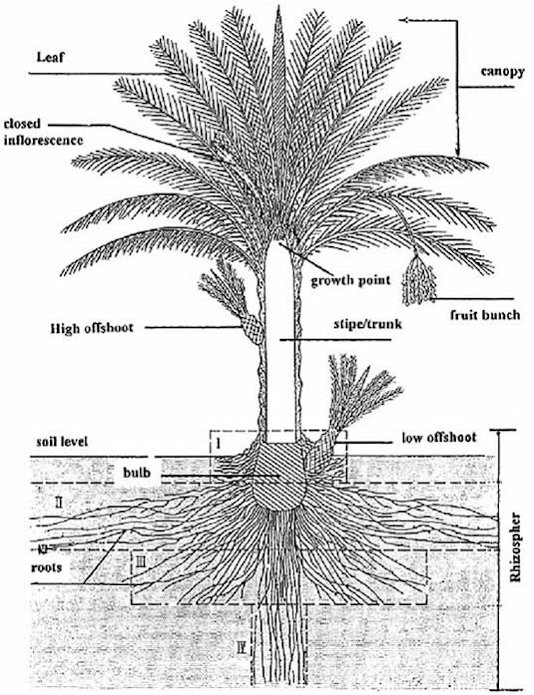
Fig. 1.
Diagrammatic construction of a date palm with its root system
(Source: Munier, 1973 and Oihabi, 1991)
3. Botanical
description
3.1
Vegetative organs
3.1.1 Root
system
Being a
monocotyledon, date palm has no tap root. Its root system is
fasciculated and roots are fibrous, similar to a maize plant. Secondary
roots appear on the primary root which develop directly from the seed.
These secondary roots produce lateral roots (tertiary roots and so on)
of the same type with approximately the same diameter throughout their
length.
The date palm root morphology and distribution are illustrated in Table
1.
TABLE 1
Date palm
root morphology and distribution
| Roots Order | Origin | Form | Average length (m) | Average diameter (mm) | Characteristics | | Primary | Trunk base | Cylinder | 4 (up to 10) | 9.5 (7-12.5) | - vertical
- adventitious
- no root hair
- conic tip
- called auxirhyzes and also main roots | | Secondary | Primary roots | Similar to primary roots | 0.20 - 0.25 | 3.5 | - called mesorhyzes | | Tertiary | Secondary roots | Similar to secondary roots but thin | 0.02-0.1 | 0.3 - 1.5 | - Low growth
- short and
- abundant called brachyrhizes |
All date palm roots present pneumatics, which are respiratory organs.
Roots are found as far as 25 m from the palm and deeper than 6 m, but
85 percent of the roots are distributed in the zone of 2 m deep and 2 m
on both lateral sides in a deep loamy soil (Munier, 1973). It is worth
mentioning that date roots can withstand wet soil for many months, but
if such conditions spread over longer periods, they become harmful to
the health of the roots and to fruit production. Fig. 1
diagrammatically shows a date palm's construction with its root
system.
From Fig. 1, it is clear that the date palm root system is divided into four zones (Oihabi, 1991):
-
Zone I, called respiratory zone: It is localised at the palm base's
surrounding area with no more than 25 cm depth and a lateral
distribution of a maximum of 0.5 m away from the stipe. Found in this
zone are mainly roots of primary and secondary nature. Most of these
roots have a negative geotropism and play a respiratory role.
-
Zone II, called nutritional zone: It is a large zone and contains the
highest proportion of primary and secondary roots. It could contain
1000 roots per m² and more than 1.60 gm of roots/100 gm soil
(Oihabi, 1991). They develop between 0.90 and 1.50 m depth and could
laterally be found outside of the projection of the tree's canopy. In
the case of Deglet Nour variety, lateral roots were found up to 10.5 m
from the trunk (Bliss, 1944). Recently planted offshoots develop their
roots at zone II then at zone III. At one year old, they could reach 1
m, while 3 m depth is easily reached at the second year.
- Zone
III, called absorbing zone: The importance of this zone is dependent on
the type of culture and on the depth of underground water. It is
usually found at a depth of 1.5 to 1.8 m. Mostly primary roots with a
decreasing density from top to bottom are found here. The density of
this zone is lower than in zone II - only about 200 roots are found per
m².
- Zone IV: The largest portion of this zone is
dependent on underground water. At a shallower depth, it becomes
difficult to distinguish between Zone III and Zone IV as both types of
roots are found here. When the underground water is deep, roots of this
zone could reach a greater depth. They usually are presented as
vaissels with a positive geotropism.
In conclusion, the root
type and distribution illustrate the role of the date palm. The lack of
roots in the top soil allows other cultures such as wheat, lucerne and
vegetables to be inter-cropped. While, the high concentration and deep
presence of primary roots allows the date palm to benefit from
underground moisture and consequently, unlike most fruit palms, resist
water stress and drought conditions.
Date palm root development
and distribution depends on soil characteristics, type of culture,
depth of the underground water and variety.
3.1.2 Trunk
The date palm trunk, also called stem or stipe is vertical, cylindrical
and columnar of the same girth all the way up. The girth does not
increase once the canopy of fronds has fully developed. It is brown in
colour, lignified and without any ramification (Figure 1). Its average
circumference is about 1 to 1.10 m.
The trunk is composed of tough, fibrous vascular bundles cemented
together in a matrix of cellular tissue which is much lignified near
the outer part of the trunk. Being a monocotyledon, date palm does not
have a cambium layer.
The trunk is covered for several years with the bases of the old dry
fronds, making it rough, but with age these bases weather and the trunk
becomes smoother with visible cicatrices of these bases. Vertical
growth of date palm is ensured by its terminal bud, called phyllophor,
and its height could reach 20 metres.
Horizontal or lateral growth is ensured by an extra fascicular cambium
which soon disappears, and which results in a constant and uniform
trunk width during the palm's entire life. However, the terminal bud
could experience an abnormal growth caused by a nutritional deficiency,
which leads to shrinkage of the trunk. This stage is mainly caused by
drought conditions.
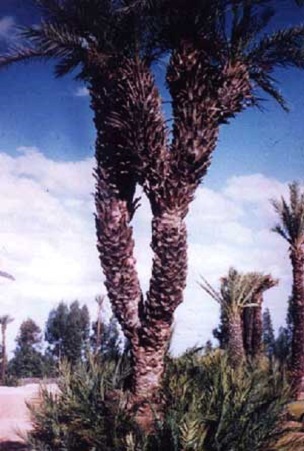 | Fig.
2
A young dichotomously branched date palm (Phoenix dactylifera
L.) at Afechtal grove (Marrakesh, Morocco). |
Sometimes date
palms show a branching phenomenon (Fig. 2) which was
studied by Zaid (1987) and found to be attributed to several causes.
The author's findings are summarized as follows:
- Branching in date palm is a result of either dichotomy, axillary bud
development, polyembryony or attack by a disease.
- Branched date palms are fertile and can produce as much fruit as a
single headed palm.
-
There is a need of an analysis of the vascular system of branched date
palm by cinematographic techniques. This anatomical study is necessary
to show the continuity of growth from the single to the divided state
of the shoot.
- It is necessary to study in vitro the
regenerating capacity of divided portions of the apical meristem and
axillary buds of these specimens in the hope of establishing a rapid
mass propagation technique for date palm.
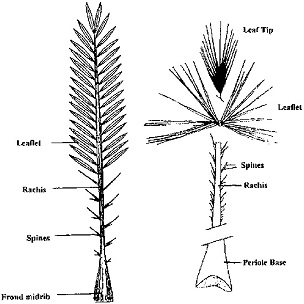 | Fig. 3 
Date palm leaf characteristics. |
3.1.3 Leaves
Depending
on variety, age of a palm and environmental conditions, leaves of a
date palm are 3 to 6 m long (4 m average) and have a normal life of 3
to 7 years. The greatest width of the frond midrib attains 0.5 m, but
elsewhere it is only half this size and rapidly narrows from the base
upwards. The frond midrib or petiole is relatively triangular in cross
section with two lateral angles and one dorsal. It is bare of spines
for a short distance but full of spines on both sides thereafter. (Fig.
3, 10 and 14). Intermediate zones have spine-like leaflets, also called
leaflet-like spines.
At the tip of the leaf, there may be a
single terminal leaflet or two leaflets forming a V (Fig. 3). Leaf
structure is variety and environment dependent, but usually the whole
length of a frond has the following proportions:
- The distance from the fibre at the base of the frond to the base of
the spine-leaflets is about 28 % of the whole frond;
- The spine-leaflets occupy about 4 %;
- The leaflets occupy about 62 %; and
- The terminal leaflets occupy about 6 %.
All
these characteristics coupled with others, are used as a taxonomical
index to differentiate between varieties. Unlike other fruit trees,
dead or old leaves are not shed and do not drop on their own, but are
removed under cultivation.
An adult date palm has
approximately 100 to 125 green leaves with an annual formation of 10 to
26 new leaves. The functional value of the leaf to the palm declines
with age and no two leaves are the same age. Furthermore, leaves which
are four years old are only about 65 percent as efficient in
photosynthesis per unit area, compared to leaves of one year old (Nixon
and Wedding, 1956). Under good cultural conditions a leaf can support
the production of 1 to 1.5 kg of dates.
Depending on their position in the palm's canopy, leaves could be
divided into 3 categories:
- On the outside, leaves are green and photosynthically active;
- At the centre, fast growing green leaves;
- On the inside, at the palm's heart, juvenile leaves, not yet
photosynthetic with a white colour.
On average, there are 40 % of juvenile leaves, 10 % fast growing leaves
and 50 % photosynthetic leaves.
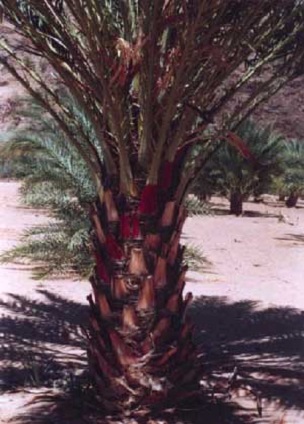 | Fig.
4
Date
palm leaves grouped in 13 columns, spiralling to the right or to the
left. |
Leaves are
grouped in 13 nearly vertical
columns, spiralling slightly to the left on some palms and to the right
on others. The grower must only count the number of leaves in one of
these columns and multiply it by 13 (Fig. 4). According to Nixon and
Carpenter (1978) and in order to allow for uneven pruning at the base,
counts could be made on opposite sides and divided by two. This
technique will allow the grower to calculate the total number of leaves
on the palm. A ratio of 8 leaves per fruit bunch will indicate how many
bunches to leave on that palm.
 | Fig.
5 
Various
development stages of a date palm seedling of Deglet Nour variety.
(Source:
Dowson, 1982) |
Leaves of
seedling date plants are
characterized by a slightly developed petiole and a juvenile leaf which
develops during the first three years after seed germination (Fig. 5).
These leaves are also called primordia, non-pinnae or entire leaves.
Adult leaves are pinnate and arise, in a flattish ascending spiral,
from buds produced by the apical growing point.
At the base
of each leaf, there is an axillary bud which could yield an
inflorescence at the palm's top level or an offshoot at its base.
According to Bouguedoura (1982), there are three distinct development
phases:
-Juvenile phase which is sterile and leads the palm
to produce more inflorescence buds than vegetative ones, which will
abort very soon.
-Second phase called vegetative, where
vegetative and flowering buds are produced in equal numbers; however,
vegetative buds are the ones which develop.
-Third phase, usually after the palm is more than 10 years old, where
most of the buds produced are flowering ones.
3.1.4 Fibre, spines and leaflets
As
well described by Dowson (1982), the base of the frond is a sheath
encircling the palm. This sheath consists of white connective tissue
ramified by vascular bundles. As the frond grows upwards, the
connective tissue largely disappears leaving the dried, and now brown,
vascular bundles as a band of tough, rough fibre attached to the
lateral edges of the lower part of the midribs of the fronds and
ensheathing the trunk. Varieties differ in the height to which the
fibre grows up the central column of unopened fronds, and in the
texture of the fibre and also somewhat in colour.
Spines,
also called thorns, vary from a few cm to 24 cm in length and from a
few mm to 1 cm in thickness. They are differentially arranged on the
two outer edges of the fronds while their number varies from 10 to
about 60. Spines can be single, in groups of two, or in groups of three.
Leaflets
or pinnae are between 120 to 240 per frond, entirely lanceolate, folded
longitudinally and oblically attached to the petiole. Their length
ranges from 15 to over 100 cm and in width from 1 to 6.3 cm. Their
arrangement depends on variety and could be in groups of 1, 2, 3, 4, or
5 pinnae (Fig. 14).
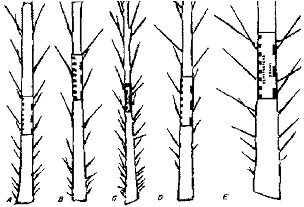 | Fig. 14 
Lower section of leaves showing spine characteristics of five commercial date varieties: A - Barhee; B - Dayri; C - Deglet Nour; E - Halawy |
3.2 Reproductive organs
Date
palm is a dioecious species with male and female flowers being produced
in clusters on separate palms. These flowering clusters are produced
with axils of leaves of the previous year's growth. In rare cases both
pistillate and staminate flowers are produced on the same spike while
the presence of hermaphrodite flowers in the inflorescence has also
been reported (Mason, 1915; Milne, 1918). Palms which carry both
unisexual and hermaphrodite flowers are known as polygamous.
The unisexual
flowers are pistillate (female)
and staminate (male) in character; they are borne in a big cluster
(inflorescence) called spadix or spike, which consists of a central
stem called rachis and several strands or spikelets (usually 50 - 150
lateral branches); (Fig. 6a, b and 7a, b).
 | Fig.
6a 
Date
palm male flowers (Source:
Dowson, 1982)
A.
Spikelet. B. Flower: 6 stamens, 3 petals, and three-toothed calyx. Most of the
flowers have 3 petals but a few have 4. C. Stamen: Length about 4 mm. |
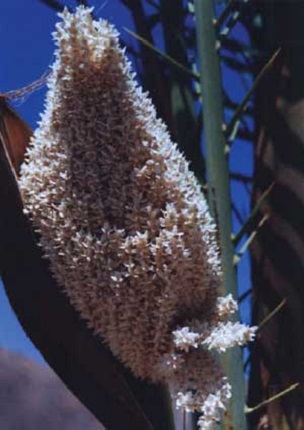 | Fig.
6b
Date palm male inflorescence 4 days after opening
(Source:
Dowson, 1982)  | Fig. 7a 
Date palm female flowers. (Source: Dowson, 1982) A.& B Two (short) spikes from different palms of the Burunsi variety. B. Four days after emergence from spathe. C. Unpollinated flower showing two of the three petals, the three-toothed calyx, and three unfertilized carpels. D. Unpollinated flower: Vertical section six days after emergence from spathe. |
|
 | Fig. 7b  Female inflorescence of a seeding date palm 3 days after opening. |
3.2.1 Inflorescences/Flowers
The
inflorescence, also called flower cluster,
in its early stages is enclosed in a hard covering/envelope known as
spathe which splits open as the flowers mature exposing the entire
inflorescence for pollination purposes (Fig. 8). The spathe protects
the delicate flowers from being shrivelled up by the intense heat until
these are mature and ready to perform their function. The spathe at the
beginning is greenish, becoming brown when near splitting - splitting
is longitudinal. The male spathes are shorter and wider than the female
ones. Each spikelet carries a large number of tiny flowers as many as
8,000 to 10,000 in female and more in male inflorescence (Chandler,
1958). The annual number of spathes born by a palm varies from none to
about 25 in females and to even more in males, but the average is a
dozen for females and more for males.
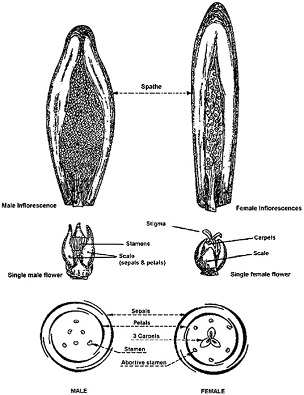 | Fig.
8 
Date
palm male and female inflorescences and flowers.
(Source:
Munier, 1973) |
The male inflorescence
is crowded at the end of the rachis, while branches of the
inflorescence of the female cluster are less densely crowded at the end
of the rachis. These characteristics allow the recognition of the
inflorescence's sex before its opening (Fig. 8). The male flower is
sweet-scented and normally has six stamens, surrounded by waxy
scale-like petals and sepals (3 each). Each stamen is composed of two
little yellowish pollen sacs.
The female flower has a
diameter of about 3 to 4 mm and has rudimentary stamens and three
carpels closely pressed together and the ovary is superior
(hypogynous). The three sepals and three petals are united together so
that only tips diverge. On opening the female flowers show more yellow
colour while the male ones show white colour dust, produced on shaking.
The pollen sacs usually open within an hour or two after the bursting
of the spathe.
Only one ovule per flower is fertilized,
leading to the development of one carpel which in turn gives a fruit
called a date; the other ovules aborted. The aborted carpels persist as
two brown spots in the calyx of ripe fruits.
3.2.2 Fruit
Depending
on the variety, environmental conditions and the technical care given
(fertilization, pollination, thinning,...), fruit characteristics vary
tremendously. Table 2 illustrates this variation:
TABLE 2
Variation of
date palm fruit characteristics
| Fruit characteristics | Weight
(g) | Length
(mm) | Colour | Width
(mm) | Taste | Consistency | | Range of variation | 2 to 60 | 18 to 110 | Large variation (yellow to black) | 8 to 32 | Large variation | Soft to dry |
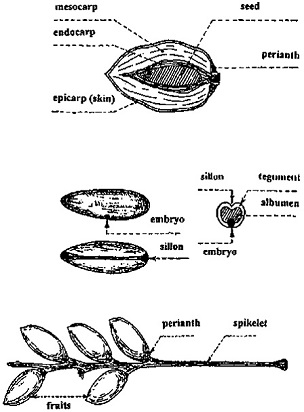 | Fig. 9 
Morphology
and anatomy of date palm fruit and seed |
The date fruit
is a single, oblong, terette,
one-seeded berry, with a terminal stigma, a fleshy pericarp and a
membranous endocarp (between the seed and the flesh) (Fig. 9).
3.2.3 Seed
As
with the fruit, seed characteristics vary according to variety,
environmental and growing conditions. A seed's weight could range from
less than 0.5 g to about 4 g, in length from about 12 to 36 mm and in
breadth from 6 to 13 mm. (Fig. 9). The seed is usually oblong,
ventrally grooved, with a small embryo, and with a hard endosperm made
of a cellulose deposit on the inside of the cell walls.
3.2.4 Variety description
Date
varieties have been developed by thousands of years of selection of
seedlings and only those possessing desirable characteristics have been
propagated. Date palm counts for more than 3,000 varieties all around
the world. There are about 400 in Iran, 370 in Iraq, 250 in Tunisia,
244 in Morocco, as well as many additional varieties in the other major
date growing countries.
Several date specialists attempted
to list and to botanically describe the varieties grown in their
respective countries. Table 3 illustrates this effort in botanical
description of date palm varieties.
TABLE 3
Number of
date varieties described per country
| Number of
varieties described | Author/Reference | | Egypt | 26 | Brown, 1924 | | Egypt and Sudan | 22 | Mason, 1925 | | Iran | 400 | FAO, 1996 | | Iraq | 370 | Dowson, 1923 | | Morocco | 244 | Saaidi, 1974 | | Tunisia | 250 | Kearney, 1906 | | USA | 196 | Nixon, 1950 |
In the present
document, the authors decided to include
an updated variety description of the two renowned varieties, Medjool
and Barhee, which have a high marketing potential.
The aim
of this description is to present these two varieties in such a way
that the date grower will become fully familiarized with their main
characteristics. The study was based on 20 random date fruits of each
variety.
Medjool
variety
Synonyms: Mejhool, Medjoul, Majhoul, Majul, Medjhool, Medjehuel, Majhol
and Me-jool.
Meaning: (Arabic); referring to its origin: Unknown
History:
Originally from Morocco (Tafilalet area) where it was the principal
export date since the 17th century and was sold in a fancy gift box for
Christmas in Paris, Madrid and London, but largely introduced into the
new world of date culture: USA (1927) and Israel (1934).
Distinguishing
characteristics: Medium size trunk, short to medium leaves which are
organised with little curvature. Has a high fruit quality (large size
and attractive). It outshines all other varieties with regard to fruit
quality and size. It is of high commercial value and is considered date
No. 1 for export market.
Description
Palm:
Leaves are short to medium (3.5-3.8m), about 1m shorter than Deglet
Nour and Barhee with a slight curvature. Dark green at early age then
change to yellow with brown strips at the middle.
Trunk: Narrow to medium diameter.
Leaf bases: Average in size with light and inconspicuous scurf on edges.
Spines:
30 to 35 in number, thick and significantly developed at the base, 1/4
of the leaf's length; usually in 2's and sometimes in 3's (Figure 10).
Lower spine's length from 5 to 10 cm and the upper ones from 15 to 20
cm.
Pinnae: Straight but could be found curved to the
middle; a taller pinnae (70 to 80 cm × 2.5 to 4 cm); width
(36 to
54 × 4.5 to 5.0 cm). On the outer centre side of the leaf
they
are open flat to 160° - 180°, and on the inner side to
50°
to 90°. At the end of the leaf, the pinnae are at 45°
on both
inner and outer sides. At the base of the leaf, the pinnae start at
50° opening to 90°. Along the length of the leaf,
pinnae
protrude at various angles (45° to 180°), in a unique
formation, specific to Medjool.
Inflorescence: Short orange base with a large number of spikelets each
with 50 to 60 flowers.
Fruitstalk:
Orange-yellow in colour; short to medium size but thick; a wax cover is
usually found at its lower half. The fruitstalk with its short length,
if not properly supported, could be broken when bearing heavily.
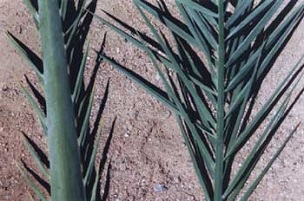 | Fig. 10
Lower section of a Medjool leaf showing spines and leaflets characteristics and distribution |
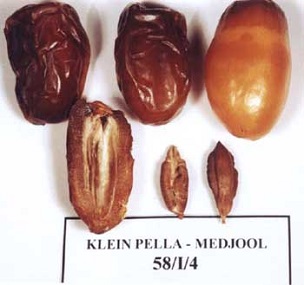 | Fig.
11
Medjool
samples showing fruit and seed characteristics |
Fruit: Very
large (20 to 40 gram) and elongated
- broadly oblong oval to somewhat ovate (5cm long by 3.2cm in
diameter). Irregularities in shape are common and are associated with
ridges on the seed. Yellow-orange with clear dark red strips at Khalal
stage. Amber at Rutab and transparent dark brown to black at Tamar
(ripe) (Fig. 11). Mature fruit colour is related to the climate and
growing conditions. Covered with a waxy structure.
The skin
is irregularly wrinkled, shiny at the peak and dull at the lower part.
Skin is medium thick and tender, tied to the flesh, but at tamar stage
it shrinks; thickness of the flesh: ± 5 to 7 mm with little
fibre. Flesh is firm, meaty and thick, brownish amber, translucent with
practically no fibre around the seed. Taste is excellent, sweet, but
not concentrated.
Seed: Walnut - Brown shiny colour darker
at the end, 1.5 gram. Seedling canal is closed approximately 50 % of
the seed diameter with small wrinkles. On each side of the seed there
is a protrusion forming a "wing shape" that is typical of Medjool and
different from all other varieties.
Fruit defects: Two main non- pathogenic defects are typical to Medjool:
a)
Loose skin: During drying, on the palm and after picking, as the flesh
looses water, the skin tends to separate from the flesh. Loose skin is
mainly the result of growing and habitat conditions. It is not affected
much by the naturally or artificially drying process. Loose skin
is an
aesthetic defect rather than a taste defect and fruit with more than 20
to 25 % loose skin are graded as Class
II.
b) Sugar crystallising: A
common problem with loose skin fruit, mainly where the skin is broken,
is that aromatic sugar crystals are formed on the flesh and
under loose
skin. Sugar crystallising is more common in fruit with high moisture content
at harvest. Again this is an aesthetic defect that will
categorise the fruit as Class II.
Pests and Fungi: During
drying, many fruits fall from the bunch without the calyx, leaving a
hole at the base of the fruit before drying is completed. Through this
hole, fermenting beetles and fungi enter the fruit and that causes the
fruit to sour. A slow drying process results in a higher level of fruit
spoiling.
Special
treatment in Medjool
Fruit size
To
achieve large and jumbo sizes, the number of fruits per spikelet and
bunch and the yield per palm must be monitored by the grower. Depending
on the overall growing conditions the following is suggested:
- Yield per palm: 80 - 120 kg
- Number of spikelets per bunch: 25 - 35
- Number of fruits per spikelet: 5 - 10
Reducing the number of fruits per spikelet could be achieved by:
1. Non- effective pollination.
2. Decreasing the number of fruit setting from flowers by chemical
spraying (not advised).
3. Hand thinning. The best results are still by hand thinning when the
fruit is at 1 to 1.5 cm in size.
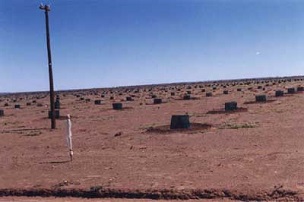 |
|
Fig.
12
Commercial
plantation of Medjool in Namibia (Naute Dam, March 1997)
|
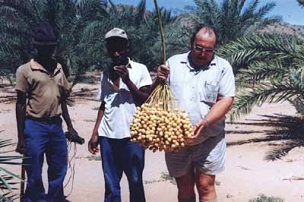 |
|
Fig.
13
First
Barhee dates produced in Namibia
(April,
1997)
|
Comments
It
is estimated that in 1996 100,000 Medjool palms, half in USA and half
in Israel, supplied the world market with 1,000 tons of Medjool fruit.
All the Medjool palms in the world, have
originated from one palm in Bou Denib (Morocco).
Medjool is an early ripening variety.
Although classified as a soft date,
Medjool is firmer than varieties like Barhee and Khadrawy.
Very
little damage from rain. Fruit quality however, is very sensitive to
temperature and humidity. Both low and high
extremes
are not suitable
for achieving high quality fruits.
Extra heavy thinning is required to
obtain a high value commercial fruit.
Easily
produces 20 to 25 offshoots per palm. In Israel Namibia RSA and USA the
Medjool and Barhee superficies are increasing annually (Fig. 12 and 13).
Barhee variety
Synonyms: Barhi, Berhi, Birhi.
Meaning: Uncertain (Arabic)
History: Barhee originates from Basrash Iiraq). Inroduced into the USA
by Popenoe (1913); also found in Egypt and Israel.
Distinguishing
Characteristics: Heavy trunk of a medium height, moderately curved
green leaves, slightly drooping pinnae. The palm has a dusty greenish
colour and looks dense and spherical. The fruit is broadly ovate round
with relatively no astringency or objectionable tannin flavour at
Khalal stage.
Description
Palm:
Leaves light elm green with a heavy whitish bloom: Sometimes the trunk
has a slight curvature near the apex caused by the weight of a heavy
crop. Leaf is long and wide. Blade length about 380 to 415 cm. Maximum
leaf width reaches 70 cm. Leaf stalk is wide and strong.
Leaf
bases: Broad, green leaves with old ones slightly narrow on edges.
Sparse scurf on edges, extending along rachis into lower blade.
Spines:
28 to 36 in number and cover approximately 1/5 of the leaf. Are short
and thin; length from 2 to 4 cm; below to 8 or 12 cm; above slender to
medium heavy; rachis angle about 15° to 40° (Figure
14). 3/4 of
spines are by pair but also found arranged in a group of 3 - 5 on each
side of the stalk. Above these, there are 5 - 6 separated spines on
each side, which are longer and thicker than the first.
Pinnae:
Are relatively wide and crowded. Rather stiff with occasional slight to
moderate drooping. Length: 60 to 72. Width: 4.5 to 5.2 cm. Grouping
usually in 2's in lower blade with a few in 3's near midblade and
above, very distinct near the apex.
Fruitstalk: Wide, long and
heavy. It is deep green at bloom and becomes greenish yellow to orange
yellow at the Khalal stage. Slight to moderate scurf on lower portion.
Fruitstalk length ± 150 cm, breadth and thickness
immediately
below fruiting head 64 × 26 mm. Length of fruiting head
±
55 cm. Strands are mid size and have the same colour as the fruitstalk.
Number of strands differs from 90 to 140. Longest strand: ±
75
to 80 cm; breadth and thickness 3.7 × 3.0 mm; fruiting area
± 42 cm; number of flowers ± 45. Shortest strand:
± 35 cm; breadth and thickness 3.9 × 2.7 mm;
fruiting area
± 26 cm; number of flowers ± 42.
Bunches: Wide, mid length and heavy with a lot of strands (up to 140
per bunch).
Fruit:
Khalal colour is opaque yellow (± apricot yellow to near
antimony yellow) internal colour of the bunch is pale; while rutab is
amber (raw sienna to amber brown) and becomes very soft and can be
easily separated from the skin. Develops into a golden brown colour in
the early tamar stage (ripe). The fruit is medium sized. Shape broadly
ovate to somewhat rounded (egg-shaped), commonly with a wedge shaped
taper from middle to bluntly pointed apex. Calyx flattened and a little
submerged, rounded-triangular, usually with 1 to 3 slight breaks in
margin.
Small fruit length (± 32.5 mm) with a big
diameter (± 25.4 mm); size ± 32 to 37 ×
23 to 30
mm. Fruit of thinned bunches may be about 31 mm long and 27 mm wide
(length to width ratio is about 1:15). Medium weight (± 15 -
20g). Flavour rich and delicate with a low total soluble solids
(± 30 %); Flesh is thick and juicy. At rutab stage, the
fruit is
very sweet. At tamar stage skin is completely separated from the flesh,
except around the calyx. The skin is greyish yellow and the flesh loses
its transparency and turns into bright to dark brown (Fig. 15).
Seed:
The seed fills the whole volume of the seed cavity. Light brown to wood
brown; oblong, slightly wider above middle, somewhat tapering to the
blunt apex. It is short and wide, (18 to 23 × 8.4 to 10.5
mm).
Germ pore central or nearly so and can be clearly seen at the centre of
seed's dorsal side. Furrow commonly medium in width and depth. Light
seed weight (± 0.88g) and a high pulp: seed ratio
(±
12.75) (Fig. 15).
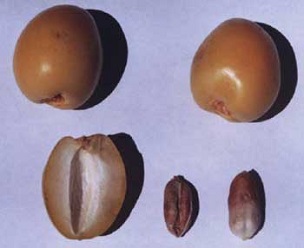 | Fig.
15
Barhee
samples (Khalal stage) showing fruit and seed characteristics |
Comments:
Barhee is a medium to late fruit ripening variety.
Yield of Barhee variety is high, reaching up to 500 kg per palm (in Israel) with an average of 200 kg per palm.
The
fruit at Khalal stage has an excellent flavour, with little
astringency, distinguishing it from all other date
varieties.
The fruit is more subject to checking and splitting than that of other varieties.
Checking
is mostly longitudinal lines from middle to apex. The skin could be a
little tough and this texture is accentuated by over
thinning.
At the tamar stage, ripe fruits are so soft and the bunches so dense that it is heavily damaged by rain.
Offshoots
production is low (usually only 3 - 5 per palm) but offshoots are large
and vigorous for their age. Palms originated from tissue culture bear
many more offshoots (up to 10 or even more).
Barhee palm and offshoots are sensitive to frost (Barhee palms were
severely damaged by the 1937 frost in the USA).
In Iraq, Israel, as
well as in international commerce, Barhee is marketed and consumed only
as fresh fruit on strands, at the Khalal
stage.
3.2.5 Growth and development stages of date palm fruit
The
growth and development of date palm fruit involves several external and
internal changes. These changes are often classified on the basis of
change in colour and chemical composition of the fruit, as five (5)
distinct stages of fruit development, known as Hababouk, Kimri, Khalal,
Rutab and Tamar.
These terms are Arabic and have been
internationally used by various authors including American and Israeli
date growers. There are no equivalent English words.
a) HABABOUK STAGE
Synonyms: Habbabok, Hababauk.
Starts
soon after fertilisation and continues until the beginning of the kimri
stage. It usually takes four to five weeks to complete and is
characterised by the loss of two unfertilised carpels; a very slow
growth rate is another characteristic. Fruit at this stage is immature
and is completely covered by the calyx and only the sharp end of the
ovary is visible. Its average weight is one gram and the size is about
that of a pea.
b) KIMRI STAGE
Synonyms: Khimri, Jimri, also called green stage.
At
this stage the fruit is quite hard, the colour is apple green and it is
not suitable for eating. This stage lasts from a small green berry to
an almost full sized green date (Figure 16). It is the longest stage of
growth and development of dates and lasts a total of nine to fourteen
weeks, depending on varieties.
During the first 4 to 5
weeks, there is an average relative weekly growth of 90 %, while during
the second period of kimri stage there is only about 22 % growth.
The
first phase is characterised by a rapid increase in weight and volume,
rapid accumulation of reducing sugars, low but increasing rate of
accumulation of total sugars and total solids, highest active acidity,
high moisture content though slightly less than that of the second
phase.
c) KHALAL STAGE
Synonyms: Khalaal, called
also colour stage.
The
fruit is physiologically mature, hard ripe and the colour changes
completely from green to greenish yellow, yellow, pink, red or scarlet
depending on the variety. It lasts three to five weeks depending on
varieties, with a low average relative weekly increase in fruit weight
(3 to 4 %). At the end of this stage, date fruit reaches its maximum
weight and size, but sugar concentration (saccharose), total sugar and
active acidity have a rapid increase associated with a decrease in
water content (around 50-85 % moisture content). It is to be noted that
date fruit accumulate most of their sugar, both the sucrose type and
the reducing sugar type, as sucrose during the Khalal stage (Table 4).
At this stage colour of the seed changes at the end from white to brown.
Some
varieties such as Barhee, Hallawi, Hayani and Zaghloul are consumed in
this stage, as they are very sweet, juicy and fibrous but not sour.
However, Khalal dates must be eaten immediately after harvesting as
they will keep for only a few days without cold storage (7°C
for
one week or 0-1 °C for longer periods) due to their high sugar
and
water content which cause fermentation during hot weather. If supply
and demand are in equilibrium, the Khalal season will last for a couple
of weeks.
Varieties harvested and marketed at Khalal stage
present the following advantages: minimum infestation, possibility of
cutting the whole bunch, easy handling and packing, high yield and
consequently high income.
d) RUTAB STAGE
Synonyms: Routab; meaning wet. Also called soft ripe stage.
At
this stage the tip at the apex starts ripening, changes in colour to
brown or black and becomes soft. It begins to lose its astringency and
starts acquiring a darker and less attractive colour from the previous
stage. However, some varieties such as Khadraoui (Iraq) and Bousekri
(Morocco) turn green at this stage.
At this stage, which in
total lasts for 2 to 4 weeks, there is a continuous decrease in fresh
fruit weight mainly due to loss of moisture (Table 5). The average
weekly decrease in fresh fruit weight is 10 % during the last week of
the rutab stage.
An increase in reducing sugar, a rapidly
increasing rate of conversion of sucrose, a gain of total sugars and
total solids also characterise this stage. It has already been observed
in respect of the reducing sugar type date, i.e. Barhee, that all the
sucrose accumulated during the previous, Khalal stage, inverts and
there is a continuous decrease in active acidity and decrease also in
moisture content (average 30 - 45 %). With softening, the last of the
tannin under the skin is precipitated in an insoluble form, so that the
fruit loses any astringency that may have remained in the Khalal stage
from the Kimri stage.
It is a very good stage for
consumption as a hard ripe date. With the exception of a few varieties,
fruit at this stage is very sweet. It is, however, very important to
harvest and market the fruit at this stage. Unless they are cold
stored, the fruits quickly turn sour and become of no commercial value.
For dessert purposes, most people prefer dates after they have passed
the Rutab stage.
e) TAMAR STAGE
Synonyms: Tamer, Tamr, also called full ripe stage or final stage in
the ripening.
This
is the stage when the dates are fully ripe, and they completely change
the colour from yellow to dull brown or almost black. The texture of
the flesh is soft. The skin in most varieties adheres to the flesh, and
wrinkles as the flesh shrinks. The colour of the skin and of the
underlying flesh darkens with time.
At this stage, the date
contains the maximum total solids and has lost most of its water to
such an extent (below 25 % down to 10 % and less) that it makes the
sugar water proportion sufficiently high to prevent fermentation. This
is the best condition for storage. The average relative decrease in
fruit weight during this stage is 35 %. The loss in fruit weight
continues if fruits are left on the palm. This stage is equivalent to
that of the raisin in the grape and the dried prune in the prune type
of plum.
At the Tamar stage, the fruits on a bunch do not
all ripen simultaneously, but over almost a month. Hence, three to four
harvest times are necessary.
Comments
Dates in all the above stages except the
Tamar are perishable, due to their high water content.
Whole
dates are harvested and marketed at three stages of their development
(Khalal, Rutab and Tamar) depending on
variety, climatic conditions and
market demand.
TABLE 4
Main changes
in the composition of the Californian Barhee during development
| Day of
sampling | Stage of
ripening | Fresh weight
of fruit in grams | Percentage | | of fresh
weight | of dry weight | water | reducing
sugars | | 23.5.39 | Kimri | 0.5 | 81 | 17 | 5 | 22 | | 21.6 | Kimri | 5 | 86 | 43 | 5 | 48 | | 2.8 | Kimri | 14 | 85 | 45 | 14 | 59 | | 2.9 | Khalal | 16 | 64 | 17 | 62 | 79 | | 11.9 | Tree-ripe (rutab) | 14 | 39 | 79 | 0.25 | 79 |
TABLE 5
Water content
of a date fruit during its maturation from Khalal to Tamar stage
| Stage | Water content (%) | | Kimri and Early Khalal | 85 | | Late Khalal | 50 | | Early Rutab (tip browning) | 45 | | 50% Rutab | 40 | | 100% Rutab | 30 | | Tamar | 24 and less |
Back to
Date Palm Page
|
















